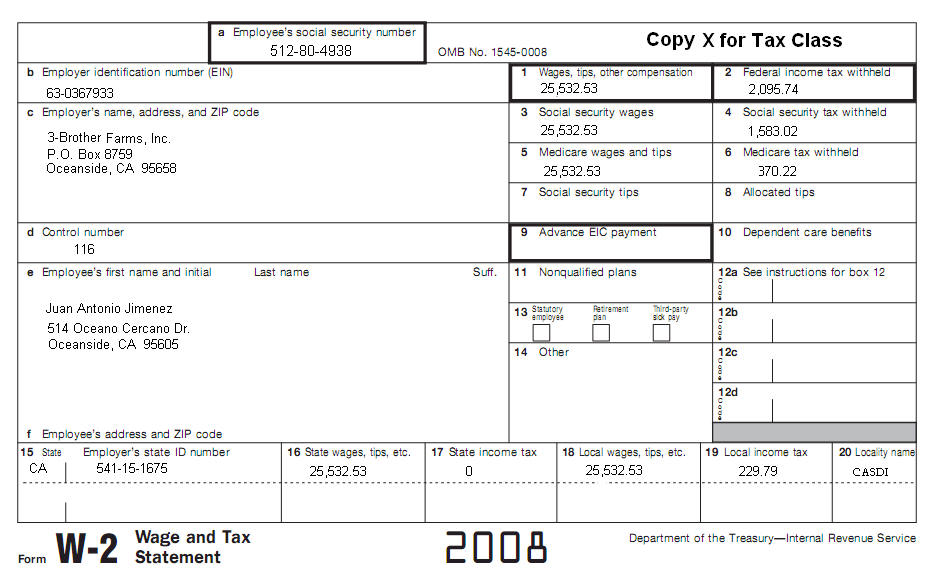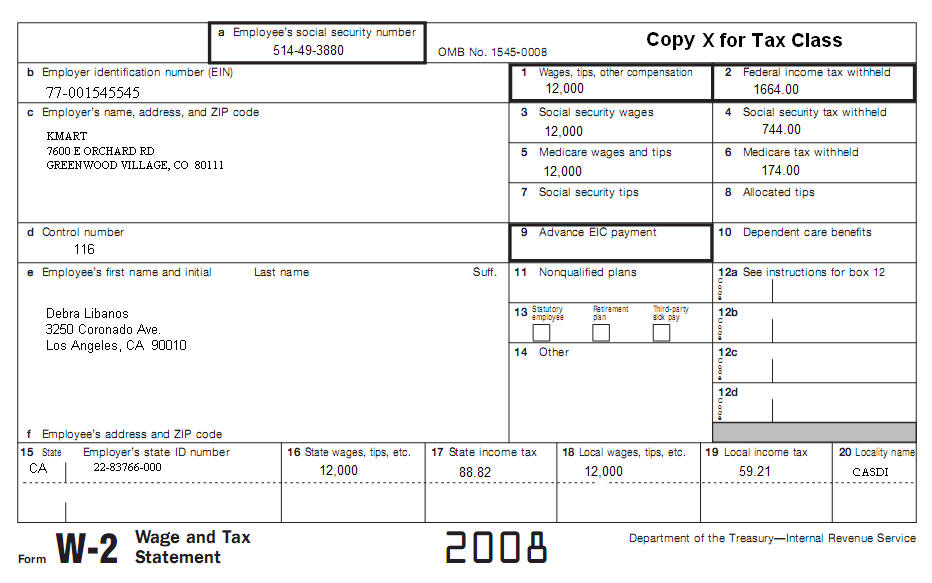|
|
|
California Tax Topic 1 - California Tax Basics
Tax School Home Page Student Instructions: Print this page, work on the questions and then submit test by mailing the answer sheet or by completing quiz online. Instructions to submit quiz online successfully: Step-by-Step check list Answer Sheet Quiz Online
Most forms are in Adobe Acrobat PDF format.
You will need California 540/540A Booklet to complete this topic. California 540/540A Booklet is a handy tool to use throughout your tax preparation career. For answers to your California tax questions you can use the different sections in the state forms as index. You many also need IRS Publication 17 and other IRS information.
1. Unemployment compensation is taxable for California. True False 2. The penalty is ____ on the tax not paid when due plus 1/2% for each month, or part of a month, the tax remains unpaid.
A.
1%. 3. In tax year 2008, if you are head of household and you would like to qualify for renter's credit, you would not qualify if your income is over what amount?
A. $34,936. 4. What is the 2008 exemption amount for California?
A. $
99 Personal exemption. 5. What is the California standard deduction amount for a single dependent who earned $4,000 from her job?
A. $
3,692 6. For California, if you and your spouse/RDP paid estimated taxes but are now filing separate returns, A.
Either you or your spouse/RDP may claim the entire amount paid. 7. You may make contributions to the California Seniors Special Fund or make other voluntary contributions of $1 or more in whole dollar amounts. The amount you contribute either reduces your overpaid tax or increases your tax due. You may contribute only to the funds listed and A.
Claim the amount you contributed as an itemize deductions expense. 8. For California, you may be entitled to claim a credit for excess State Disability Insurance (SDI) or Voluntary Plan Disability Insurance (VPDI) only if you
A. Had two or more California employers during 2008. 9. For California, this filing status is for unmarried individuals and certain married individuals living apart (considered unmarried) who provide a home for which you paid more than half of the upkeep for certain other persons. The qualifying person lived in your home for more than half of the year and you were not a nonresident alien at any time during the tax year 2008. You are entitled to use the A.
Single filing status. 10. If you were 65 of age or older by December 31, 2008, you should claim an additional exemption credit on line 9 Form 540A. For exemption purposes, you are considered to be 65 on December 31, 2008 if A.
Your 65th birthday is on January 1, 2009. Prepare a California Form 540A return for Juan Antonio and Maria Jimenez. Get all their basic information from the following W2, including income information. You may also need Federal IRS Form 1040A. Juan is married to Maria Jimenez (SSN 512-80-8221 Maria's). Neither Juan nor Maria can be claimed as dependents on another return. They have a daughter and her name is: Andrea Jimenez (D.O.B. born 9-16-1990 and ITIN* 900-56-9161). Andrea lived with them for all of the 2008 tax year. Juan and Maria are the only ones providing support for Andrea for all of 2008.
11. Look at the Form 540A you prepared for Juan and Maria. What is the amount on Form 540A, Line 18?
A. $ 3,516. 12. Look at the Form 540A you prepared for Juan and Maria. What is the amount on Form 540A, Line 66?
A. $ 430. 13. For California, you are considered single if A.
You were never married or an RDP. 14. For California, head of household is for unmarried individuals and certain married individuals or RDPs living apart who provide a home for a specified relative. Which of the following disqualifies you to use the head of household filing status. A.
You paid more than half the cost of keeping up your home for the year in
2008. 15. For California, you may be able to file as head of household if your child lived with you and you lived with your spouse/RDP during the entire last six months of 2008. True False 16. Use the same filing status for California that you used for your federal income tax return, unless you A.
Itemize your deductions. 17. Beginning in 2005 for a child to qualify as your foster child for head of household purpose, the child must A.
Be placed with you by an authorized placement agency. 18. You must use the same filing status for California that you used for your federal income tax return unless in cases when a spouse is a member of the Armed forces or a nonresident for the entire year and no income from California source. According to federal law, if you are living together in a common law marriage that is recognized in the state where you now live or in the state where the common law marriage began you are considered married for tax purposes. You are considered married for California purposes if A.
You were married as of December 31, 2008, even if you did not live with
your spouse/RDP at the end of 2008. 19. You normally must use the same filing status for California that you used for your federal income tax return. However, if you filed a joint return for federal you may file separately for California, if either spouse was: A.
An active member of the United State armed forces or any auxiliary
military branch during 2008. 20. If you file a joint return for federal, you may file separately for California if either spouse was a nonresident for the entire year and had no income from California sources during 2008. However, if the spouse earning the California source income is domiciled in a community property state, community income will be split equally between the spouses. Therefore, they will not qualify for the nonresident spouse exception because A.
Both spouses were domiciled out of California.
Get all their basic information from the following W2, including income information. Complete a Form 540A. Use the following attached W2, information on W2 is current.
Debra has her niece Tsehay Adaba, (D.O.B. born 8-23-2001 and SSN 610-04-1090) whom she would like to claim on her tax return. Tsehey didn't live with Debra. However, Debra provided more than half of Tsehay's support. No one else can claim Tsehay or Debra as a dependent.
21. Look at the Form 540A you prepared for Debra Libanos. What is the amount on Form 540A, Line 21?
A. $ 409. 22. Look at the Form 540A you prepared for Debra Libanos. What is the amount on Form 540A, Line 66?
A. $ 102. 23. For California, the first year you claim the blind exemption, attach a doctor's statement to the back of Form 540 or 540A indicating you or your spouse/RDP are visually impaired. True False 24. For California, you are considered to be age 65 on December 31, 2008 if your 65 birthday is on (or before)
A.
December 31, 2008. 25. Fill in the circle on line 6 of Form 540 or 540A, if someone else can claim you or your spouse/RDP as a dependent on his or her tax return only if he or she will claim you. True False 26. Use your exemption credits to reduce your tax. Your exemption credits will be limited if you are Married filing jointly and your federal adjusted gross income (AGI) (540 line 13, 540A line 13) is more than
A. $ 244,785. 27. Raphael is filing Single for 2008. He has no dependents. The exemption amount that he claims from California may be limited. His total earnings from work (federal adjusted gross income) were $159,000 for the whole year. Figure his exemption amount for 2008.
A.
$ 3,500 28. What are the California exemption amounts for 2008?
A. Personal and spousal exemptions $ 99. 29. Jeremy thinks that his exemption credits will be limited. He qualifies for the Head of household filing status. His federal adjusted gross income (540A line 12b) is $180,000. Over what amount does Jeremy need to make to even consider calculating his California exemption credit limitation worksheets? A. $
100,000. 30. Marie has 4 children that qualify as her dependents. No one can claim her or her children on someone else's return. Her total earning from work are $39,000. What is the total exemption amount that Marie will claim on her California return?
A. $ 99
|
| Back to Tax School Homepage |



